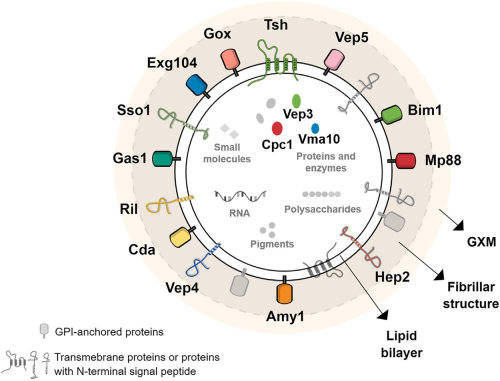Cryptococcus neoformans-derived Exosome Research and Application
Cryptococcus neoformans is a basidiomycete fungus that adapts to the human body temperature environment. As a significant environmental pathogen, it poses a severe challenge to public health safety. Its infection and mortality rates remain high, further emphasizing the urgency of unveiling its pathogenic mechanisms. In this process, research on exosomes released by Cryptococcus neoformans is crucial. Increasing evidence suggests that these Cryptococcus neoformans-derived exosomes play a key role in the interaction between the bacterium and its host. As a pioneer in the field of exosome development, Creative Biolabs provides professional technical support for research projects on microbe-derived exosomes, contributing to a deeper understanding and effective combat against this potential deadly pathogen.
Characteristics of Cryptococcus neoformans
Cryptococcus neoformans has the following characteristics:
1. Adaptation to host environment: Cryptococcus neoformans can grow rapidly within the range of 37°C to 40°C, which is one of the primary conditions for becoming a human pathogen. It can also acquire essential life substances in the body, such as iron ions, which are crucial for its survival.
2. Virulence factors: The infection of Cryptococcus neoformans is closely related to its virulence factors, mainly including extracellular polysaccharide capsules, melanin, and urease. These virulence factors not only help to kill host cells but also assist Cryptococcus in resisting the host's immune response.
3. Morphological diversity: Cryptococcus neoformans has a variety of cellular morphologies, including yeast cells, titan cells, hyphae, and spores, which helps it adapt to changing environments and host microenvironments.
Exosomes are found in many microbes, serving as a means of cell-to-cell communication. For Cryptococcus neoformans, its exosomes may also play a critical role. In-depth research on Cryptococcus neoformans-derived exosomes not only helps us better understand the complexity of its interaction with the host but may also provide key clues for developing new diagnostic and treatment strategies.
Key Roles of Cryptococcus neoformans-Derived Exosomes
-
Cell wall penetration mechanism: Studies using electron microscopy techniques have found that these exosomes can penetrate the dense fungal cell wall and enter the extracellular space.
-
Pathogen transmission: Exosomes play a role in the transmission of virulence factors exported by Cryptococcus neoformans, directly affecting the interaction between Cryptococcus neoformans and the host.
-
Modulation of host macrophages: These exosomes can interact with the host's macrophages, increasing the release of cytokines (such as TNF-alpha, IL-10, TGF-beta), and stimulating macrophages to produce antimicrobial compounds (such as nitric oxide). This suggests that they can activate the host's immune system to enhance defense against Cryptococcus neoformans.
-
Immune response regulation: The exosomes released by Cryptococcus neoformans under different nutritional conditions show significant differences in size, carried virulence compounds, and induced inflammatory responses. This indicates that exosomes are involved in regulating the host's immune response during the infection process of Cryptococcus neoformans.
-
Promotion of brain infections: Research has found that these exosomes can enhance the passage of Cryptococcus neoformans through the blood-brain barrier, thereby increasing the risk of brain infection. These exosomes can fuse with human brain microvascular endothelial cells, possibly by activating the cells' membrane vesicles and promoting fusogenic activities.
-
Interference by serum proteins: Studies have shown that serum proteins (such as albumin) can disrupt these exosomes, which may be a host defense mechanism to promote the unloading and absorption of carriers in these exosomes.
Potential Vaccine from Cryptococcus neoformans-derived Exosomes
The exosomes released by Cryptococcus neoformans have been proven to contain surface protective antigens, similar to the structure of enveloped viruses. In animal experiments, mice vaccinated with these exosomes showed a strong antibody response and significantly prolonged survival after infection with Cryptococcus neoformans.
 Fig.1 Model of simplified molecular structure and composition of Cryptococcus extracellular vesicles.1,2
Fig.1 Model of simplified molecular structure and composition of Cryptococcus extracellular vesicles.1,2
Creative Biolabs has successfully built an advanced research platform for microbe-derived exosomes and is committed to providing comprehensive exosome development support services to clients worldwide. If you have any needs, please feel free to contact us.
Microorganism-derived Exosome Isolation and Identification
In Vitro Functional Discovery of Microorganism-derived Exosomes
In Vivo Functional Discovery of Microorganism-derived Exosomes
References
-
Rizzo, J.; et al. Cryptococcus extracellular vesicles properties and their use as vaccine platforms. Journal of Extracellular Vesicles. 2021, 10(10):e12129.
-
under Open Access license CC BY 4.0, without modification.
For Research Use Only. Cannot be used by patients.
Related Services:

 Fig.1 Model of simplified molecular structure and composition of Cryptococcus extracellular vesicles.1,2
Fig.1 Model of simplified molecular structure and composition of Cryptococcus extracellular vesicles.1,2









